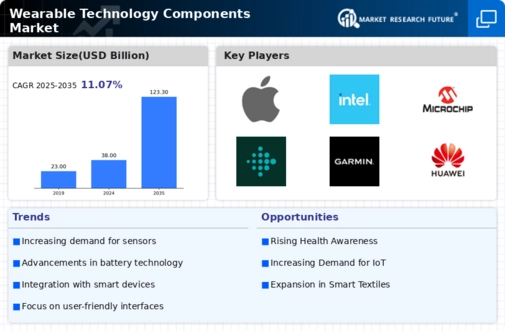Top Industry Leaders in the Wearable Technology Components Market

A Competitive Landscape of Wearable Tech Components
The wearable technology market pulsates with innovation, driven by a vibrant ecosystem of component manufacturers vying for dominance. Understanding this competitive landscape is crucial for navigating the intricate assembly of market share, strategic maneuvers, and new players disrupting the existing order.
Some of the Wearable Technology Component companies listed below:
- Adidas
- Apple Inc.
- Xiaomi
- Garmin
- Fitbit
- Samsung Electronics
- Nike
- Qualcomm Technologies
Strategies Adopted by Key Players:
-
Innovation blitz: Continuous investment in R&D fuels the race for miniaturization, enhanced battery life, and cutting-edge functionalities like bio-sensing and advanced health monitoring. -
Ecosystem building: Cultivating vibrant app ecosystems and partnerships with fitness platforms and healthcare providers strengthens brand loyalty and expands potential use cases. -
Vertical integration: Integrating design, manufacturing, and software development optimizes supply chains, reduces costs, and enhances product control. -
Strategic acquisitions and partnerships: Mergers and collaborations accelerate technology advancements, expand market reach, and access new customer segments.
Gauging Market Share Dominance:
-
Revenue and unit shipments: Traditional metrics like market share by revenue and unit shipments offer a broad understanding of a company's financial performance and product penetration. -
Technological leadership: Metrics like patent filings, R&D investment, and platform adoption gauge a company's contribution to industry advancements and future potential. -
Geographic reach: Presence across diverse markets, particularly high-growth regions like Asia-Pacific, indicates a company's adaptability and global competitiveness.
Emerging Challengers and Disruptors:
-
Startups: Nimble and innovation-driven, startups like Amazfit, Mobvoi, and Huami bring cost-effective wearables to market, catering to price-sensitive consumers. -
Fashion brands: Collaborations with tech giants like Google and Fossil blur the lines between fashion and technology, attracting fashion-conscious consumers. -
Non-traditional players: Sports apparel giants like Adidas and Under Armour leverage their brand recognition and athletic expertise to develop performance-oriented wearables.
Latest Company Updates:
On July 20, 2023, Hapbee Technologies, Inc. (HAPB), the sleeping technology company, announced a partnership with a payment integration services provider, TrueMed, to help customers save pre-tax costs by 30-40 percent. TrueMed will enable customers to use their health savings account (HSA) and flexible spending account (FSA) to purchase Hapbee devices. By enabling pre-tax savings through HSA and FSA cards, Hapbee aims to empower individuals to take control of their well-being and experience the transformative effects of our wearable technology.
On May 01, 2023, A research team at the University of Washington announced the development of an active component of the biopolymer sensor, a molecular switch designed using molecular dynamics techniques and AI. These molecular switches have been made of synthetic proteins that act like a lock & key in a cage and are sensitive to a particular analyte.
On Dec. 23, 2022, Chargeurs PCC Fashion Technologies, an apparel interlinings manufacturer, announced signing a global distribution agreement with KC Wearable Technologies for the clothing and retail industries. Chargeurs will distribute KC Wearable's wearable technology components globally. The agreement will allow brands to offer customers new state-of-the-art fashion technologies that provide heating & cooling properties, antibacterial protection, wireless charging capabilities, and other benefits.
On Apr.07, 2022, Engineers at UC Berkeley announced the development of a new technique for making sensors for wearable technology, enabling medical researchers to prototype-test new designs much faster and at a far lower cost than existing methods. Rigid electronics and sensor components, such as commercial resistors, capacitors, and lab-synthesized components like carbon nanotubes, enable fast, low-cost sensor prototyping for wearable technology.
